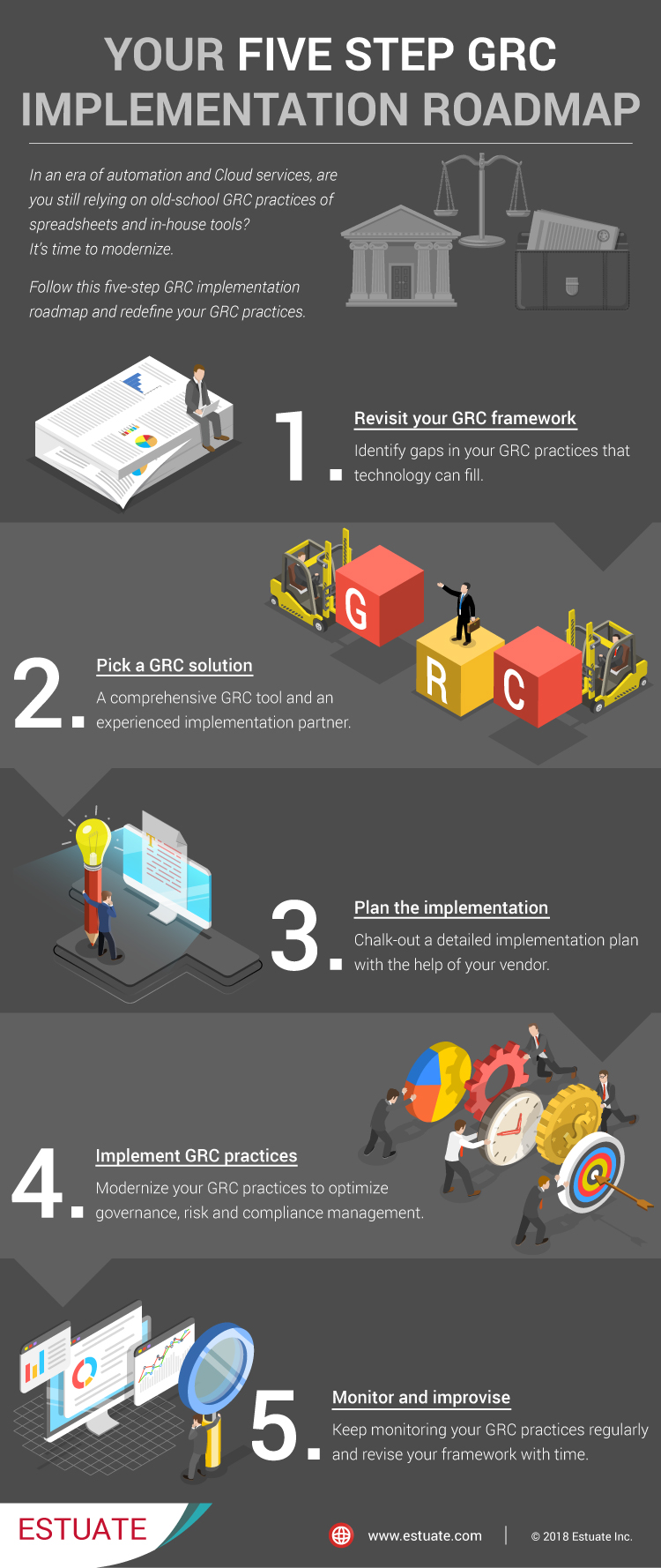
The concept of Governance, Risk and Compliance has been around for some time. Although there is no single, universally accepted definition for GRC, it is basically a comprehensive business strategy that aims at ensuring corporate governance and mitigating enterprise risk while staying in compliance with regulatory policies. It establishes clear guidelines for operations and a mechanism to prevent and fight business risks. It comprises of three main pillars.
Governance, ensuring business processes and corporate policies are practiced throughout the organization.
Risk, identifying the potential areas of risk and preparing the organization to minimize and prevent them.
Compliance, the ability to comply with legal and regulatory requirements and business policies.
For years, businesses have followed old school ways of implementing GRC programs using traditional methodologies such as spreadsheets and in-house tools. However, with emergence of breakthrough technologies like AI, Cloud and automation, the concept of GRC has evolved and modernized.
Although we have been slow in adopting technology-driven GRC practices, lately there has been a significant shift towards businesses leveraging automated GRC strategies at enterprise levels. So much so, that the global GRC market is expected to reach $64.61 billion by 2025.
Today, all modern enterprises need to let go of traditional GRC practices and modernize their approach. But how do you get there? How can you adopt a winning GRC strategy? Here is a five-step GRC implementation roadmap that can help you plan, strategize and implement modern GRC practices effectively in your organization.
Revisit your GRC framework
To start with, you need to review your existing GRC framework and identify the gaps that technology can fill. It would mean redefining what governance, compliance and risk means for your enterprise. A clear understanding of your key business objectives and important business processes will help you adopt the right GRC technology and develop appropriate policies, procedures and guidelines for your business.
Select a GRC Solution
In order to ensure effective functioning of a GRC initiative, it is important that you pick the right implementation partner and an ideal GRC solution for your enterprise. There are tons of GRC tools and hundreds of vendors in the market.Cloud based GRC solutions are most popular nowadays. MetricStream, BWise, SAP, Riskonnect, RSA Archer etc. are some market-leading GRC products available today. Go for a solution that comes with all the features you’re looking for. Also, do your research and select an experienced vendor that can implement GRC within a reasonable time-frame with maximum efficiency.
Project Planning
This step involves chalking out a well-defined GRC implementation plan. A business analyst or project manager appointed by the vendor visits your premises and spends time understanding your existing business processes and policies. He also conducts a risk assessment of your business and identifies areas that need to be protected.
He then develops an integrated GRC plan that best suits your organization, including a detailed demo of the selected GRC product, assigning roles and responsibilities and defining project timelines.
Implement GRC Practices
Once a detailed plan is developed, the next and the most crucial step is implementing GRC practices at your enterprise. Today, most GRC programs are Cloud driven and automated. Implementation involves policy and document management, operational risk management, IT risk management and corporate compliance management. It also includes spreading awareness about the new GRC policies and training people within the organization to practice them.
Monitor and Improvise
Implementing a GRC program is not a one-time activity. It is a continuous business practice and must be followed every day across all departments. It is therefore important to closely monitor and ensure that GRC practices are well followed within the enterprise. Also, since the business world is highly dynamic, you must modernize your GRC platform and revise your policies regularly to match business, industry and regulatory requirements.

GRC is essential because it brings about a stability in the way a business performs. It improves the quality of people, processes and information within an organization providing meaningful insights for better decision making. It is not just a good initiative anymore, it is an essential business requisite. Adopting a modern GRC program leads to a remarkable organizational change. However, the key to successful implementation is to have a clear strategy and take one step at a time.